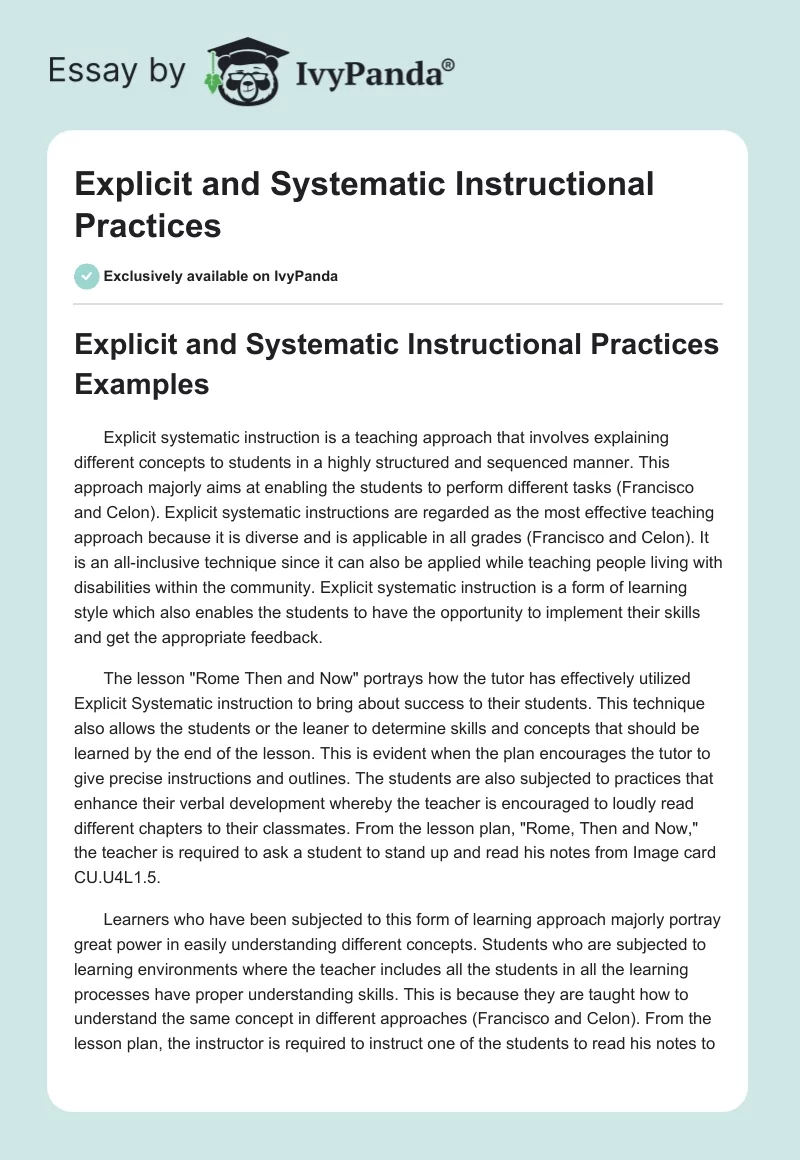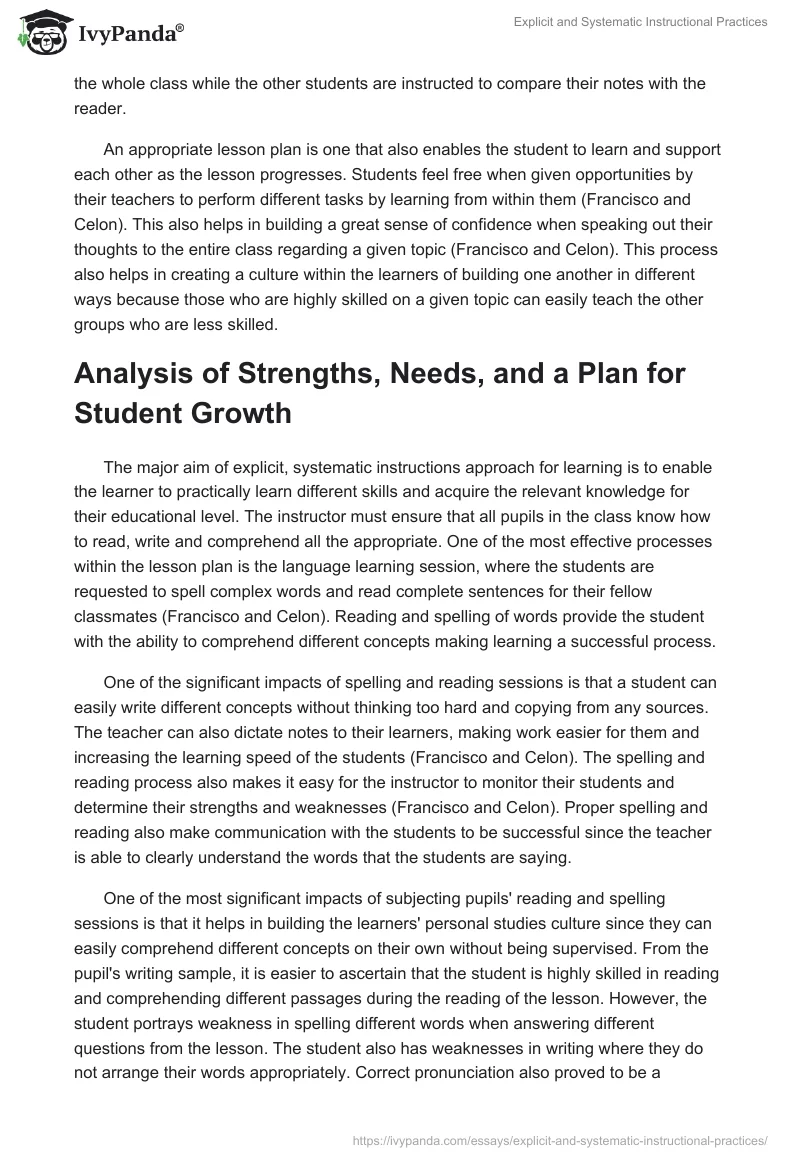Explicit and Systematic Instructional Practices Examples
Explicit systematic instruction is a teaching approach that involves explaining different concepts to students in a highly structured and sequenced manner. This approach majorly aims at enabling the students to perform different tasks (Francisco and Celon). Explicit systematic instructions are regarded as the most effective teaching approach because it is diverse and is applicable in all grades (Francisco and Celon). It is an all-inclusive technique since it can also be applied while teaching people living with disabilities within the community. Explicit systematic instruction is a form of learning style which also enables the students to have the opportunity to implement their skills and get the appropriate feedback.
The lesson “Rome Then and Now” portrays how the tutor has effectively utilized Explicit Systematic instruction to bring about success to their students. This technique also allows the students or the leaner to determine skills and concepts that should be learned by the end of the lesson. This is evident when the plan encourages the tutor to give precise instructions and outlines. The students are also subjected to practices that enhance their verbal development whereby the teacher is encouraged to loudly read different chapters to their classmates. From the lesson plan, “Rome, Then and Now,” the teacher is required to ask a student to stand up and read his notes from Image card CU.U4L1.5.
Learners who have been subjected to this form of learning approach majorly portray great power in easily understanding different concepts. Students who are subjected to learning environments where the teacher includes all the students in all the learning processes have proper understanding skills. This is because they are taught how to understand the same concept in different approaches (Francisco and Celon). From the lesson plan, the instructor is required to instruct one of the students to read his notes to the whole class while the other students are instructed to compare their notes with the reader.
An appropriate lesson plan is one that also enables the student to learn and support each other as the lesson progresses. Students feel free when given opportunities by their teachers to perform different tasks by learning from within them (Francisco and Celon). This also helps in building a great sense of confidence when speaking out their thoughts to the entire class regarding a given topic (Francisco and Celon). This process also helps in creating a culture within the learners of building one another in different ways because those who are highly skilled on a given topic can easily teach the other groups who are less skilled.
Analysis of Strengths, Needs, and a Plan for Student Growth
The major aim of explicit, systematic instructions approach for learning is to enable the learner to practically learn different skills and acquire the relevant knowledge for their educational level. The instructor must ensure that all pupils in the class know how to read, write and comprehend all the appropriate. One of the most effective processes within the lesson plan is the language learning session, where the students are requested to spell complex words and read complete sentences for their fellow classmates (Francisco and Celon). Reading and spelling of words provide the student with the ability to comprehend different concepts making learning a successful process.
One of the significant impacts of spelling and reading sessions is that a student can easily write different concepts without thinking too hard and copying from any sources. The teacher can also dictate notes to their learners, making work easier for them and increasing the learning speed of the students (Francisco and Celon). The spelling and reading process also makes it easy for the instructor to monitor their students and determine their strengths and weaknesses (Francisco and Celon). Proper spelling and reading also make communication with the students to be successful since the teacher is able to clearly understand the words that the students are saying.
One of the most significant impacts of subjecting pupils’ reading and spelling sessions is that it helps in building the learners’ personal studies culture since they can easily comprehend different concepts on their own without being supervised. From the pupil’s writing sample, it is easier to ascertain that the student is highly skilled in reading and comprehending different passages during the reading of the lesson. However, the student portrays weakness in spelling different words when answering different questions from the lesson. The student also has weaknesses in writing where they do not arrange their words appropriately. Correct pronunciation also proved to be a difficulty to the learner since some of the pronunciations from his answers were not correct.
The positive impact of the systematic, explicit instructions to the pupil is that it will enable them to learn how to spell different words correctly. Incorporating reading and spelling instructions in the lesson plan will also help the student to gain the appropriate pronunciations of different sounds, making the understanding effective and successful. The student will also develop confidence in writing and reading speeches made for the public domain (Francisco and Celon). The student’s growth is a process considered to be very progressive. The systematic explicit instruction teaching approach is the most appropriate since it involves monitoring the student’s strengths and weaknesses (Francisco and Celon). The tutor then adopts an appropriate action based on the approach to enable the pupil to understand different concepts in class.
Work Cited
Francisco, C, and L Celon. “Teachers’ Instructional Practices and Its Effects on Students’ Academic Performance.” International Journal of Scientific Research in Research Paper. Multidisciplinary Studies E, vol. 6, no. 7, 2020, pp. 64–71, Web


